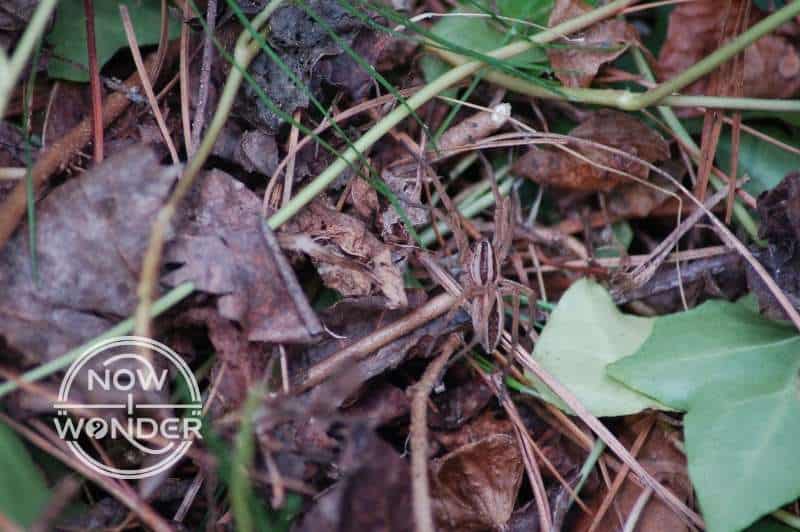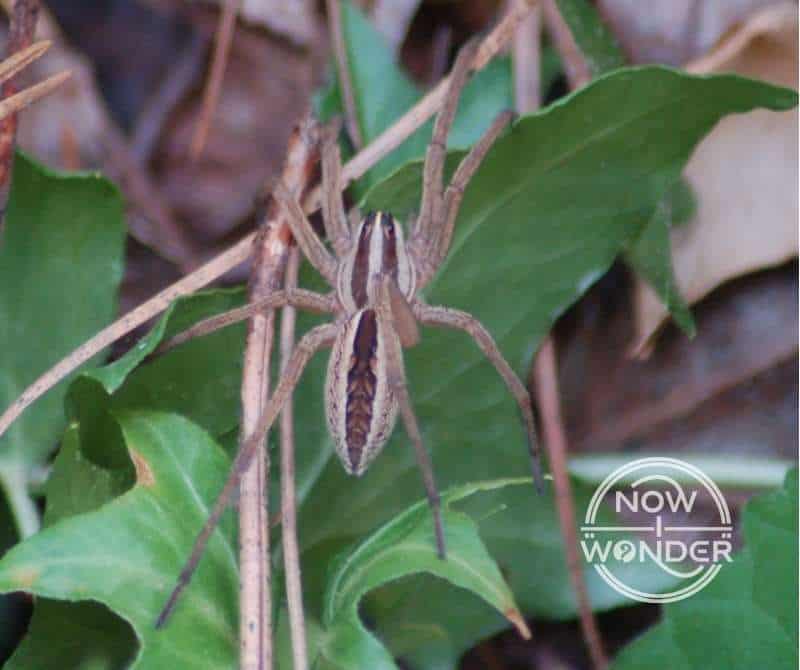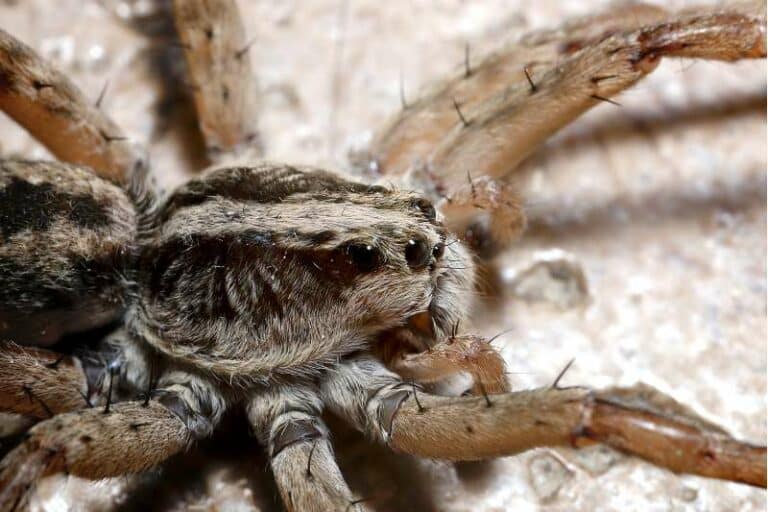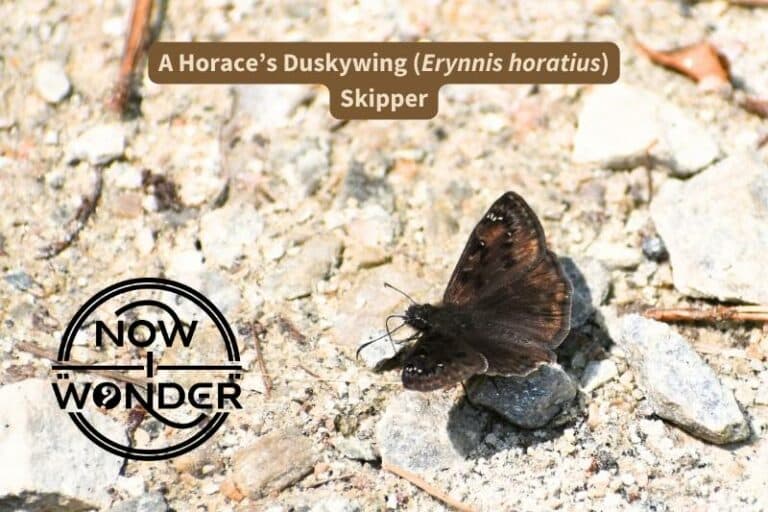The world contains huge numbers of spiders, both identified species and individuals. Spiders are notorious for hanging motionless in huge webs but there is a group of sizable spiders that don’t make webs at all; rather they actively hunt their prey on the ground. These are the wolf spiders of family Lycosidae and some of the biggest representatives live right here in the southeastern United States.
What is a wolf spider?
“Wolf spider” is the common name for spiders classified within Family Lycosidae. They are large, fast, ground-based, nocturnal hunters that use camouflage to blend into their surroundings. They do not build webs but use camouflage and speed to ambush prey, killing them their venomous fangs.
Wolf spiders are startlingly and impressively big arachnids, especially when one surprises you by running right over your hand while gardening (go ahead, ask me how I know). Read on to learn about these amazing (and intimidating!) spiders.
What is the largest wolf spider in North Carolina?
The largest wolf spider in North Carolina is the Carolina wolf spider (Hogna carolinensis) which grows 18 – 35 mm (0.71 – 1.4 in). The second largest is the rabid wolf spider (Rabidosa rabida) 13 – 21 mm (0.5 – 0.875 inches). Both species are sexually dimorphic; females are larger than males.
NOTE: Rabid wolf spiders are not rabid and do not carry or transmit the rabies virus. Early peoples granted them this name because they feared their bite, likely due to the spiders’ large size and intimidating appearance.

Where do wolf spiders live?
Wolf spiders live around the world; over 200 species are found in North America. They live in areas that support insects, especially meadows and forests. Some species live in burrows inches to feet deep; others simply hide from predators under low foliage or leaf litter.
What do wolf spiders eat?
Like all spiders, wolf spiders are carnivorous and eat a variety of insects, such as grasshoppers, crickets, beetles, and caterpillars, as well as other small invertebrates. Up to 25% of their diet can consist of other arachnids, including smaller individuals of the same species.
Unlike other spider families, wolf spiders do not build webs to ensnare flying insects but some species do have the ability to make silk. They use silk to bind prey, line their burrows, and trail drag lines behind them as they travel through their territories.
Wolf spiders are ambush ground hunters. A spider will pick a spot and wait motionless for something delectable to wander by. If nothing does, it will search for a better location; these spiders cover a lot of ground coursing for prey.
If an insect wanders too close to where the spider is waiting, the spider sprints out and grabs it. What happens next depends in large part on the size of the prey.
“If the prey is small, the spider may pounce on it and bite immediately. If the prey is larger, the spider may grapple with the prey, grasp with its legs and briefly tumble upside down, holding the prey in a basket formed by the eight legs. Then the spider bites its prey. Within moments, the spider is upright again, holding the prey below its body, caged by its legs.” (Bradley 2012).
Wolf spiders are solitary, predatory, and very aggressive hunters – even of their fellow wolf spiders – which can make both male-male and female-male encounters dangerous.

The dangers of cannibalism
Male – Male Interactions
Interactions between males are less dangerous than those involving males and females because male wolf spiders are closer in size to each other than the average male compared to the average female. But “less dangerous” still means “dangerous; males risk being attacked any time they come into contact with one another.
When two males encounter each other, they may attempt to communicate dominance by waving their forelegs in the air and striking the ground with their legs or bodies. However, despite this signaling behavior, confrontations between two males often turn physical.
Male wolf spiders fight by grappling; they don’t usually deploy their venomous fangs. Each male attempts to shove the other around to the point where his opponent flees. Because this is a straight contest of strength, mass, and leverage, the bigger, heavier male usually wins the contest, proving his physical superiority.
The losing male must retreat quickly or risk becoming prey for the larger, heavier spider as the winner has proven himself capable of overpowering the loser.
Male – Female Interactions
Approaching a female with the intent to mate is more dangerous for males than actually fighting for dominance. Wolf spiders are sexually dimorphic; females grow substantially larger than males. Because wolf spiders can be cannibalistic, there is an equally high chance a female may decide to attack and eat a smaller male as that she will opt to mate with him. Male spiders truly roll the dice on their lives in order to mate.
The silk drag lines wolf spiders extend behind them have special significance in their lives and behaviors, especially for males searching for mates.
Drag line silk contains pheromones that provide information about the source spider to any other wolf spider who encounters it. Male wolf spiders will follow drag lines extended by females to initiate mating and may pluck the lines from a safe distance as they move closer. The vibrations travel down the strand and warn the females of their approach, hopefully reorienting the females away from their default “pounce, bite, kill, eat” settings and towards mating.
Once within visual range of the female, males engage in elaborate behaviors that communicate their intentions to the females from a safe distance.
A male who wants to mate with a female must overcome two large hurdles. The first hurdle is convincing the female that the male is a fellow spider of the same species and thus, a potential mate. The second hurdle is to demonstrate that he is more valuable to the female as a mate than as a meal.
Wolf spiders have excellent vision, thanks to eight eyes arranged in three rows. Four small eyes are positioned on the front of the cephalothorax, two large eyes are positioned slightly above these, and two medium-sized eyes are positioned far back on the head. So not only do wolf spiders have acute vision, they can also see well in all directions.
A male spider will combine visual and tactile signals to assess the female’s willingness to mate. He will wave his legs and/or pedipalps while the female watches and will strike the ground with his legs to create vibrations that the females sense through their legs.
These behaviors have been characterized as: “leg extend” (spider raises one foreleg, both forelegs, the first two pairs of legs, or the first two legs on the same side), “double-tap” (spider raises both forelegs before crashing them down against the ground), and “jerky tap” (spider bangs his entire body against the ground while striking the ground with his forelegs) (Delaney, Roberts, and Uetz).

Both forms of signaling seem to be equally important in helping the females decide which males they wish to mate with. Female wolf spiders communicated sexual receptivity to displaying males 93% of the time when they could both see the males’ movements and feel the vibrations the males made through the substrate. In contrast, when the females could only sense one or the other (i.e. only see but not feel or feel but not see), the percentage dropped into the 60s (Scheffer Uetz, Stratton 1996).
Females decide whether they are receptive to mating with a given male quickly. If a female is willing to mate, she turns either 180 degrees or in a full circle, then crouches down with her abdomen raised (Scheffer, Uetz, Stratton, 1996). This signals to the male that it is safe to come closer and copulate.
Copulation usually happens within four minutes of her assuming the receptive position (Scheffer, Uetz, Stratton 1996). If the female doesn’t communicate receptivity fairly early in the interaction, the male is in danger and better cut and run before the female becomes aggressive.
Females seem to choose mates in large part based on the energy and vigor with which a male displays for her (i.e. leg tapping, jerky tapping, etc.). Displaying for a female takes a lot of energy so prolonged and energetic displays gives the female indirect information about the male’s fitness. Males that do the most signaling (i.e. courting behaviors) are more apt to successfully mate (Delaney, Roberts, Uetz, 2007).
This indirect assessment is very different from the direct physical confrontations in which males engage.
Parental care – spider style
Once mated, female wolf spiders provide a surprising amount of parental care, initially to the eggs and then to their spiderlings. A female constructs the egg sac, then attaches it to her spinnerets and carries it with her as she wanders in search of prey.
When the young emerge from the egg sac, they climb up onto her body and get carried around under her protection while they grow. After a few weeks, the spiderlings are large enough to survive on their own so they drop off the female’s body and disperse.
What eats wolf spiders?
Wolf spiders are preyed upon by birds such as chickadees, Carolina wrens, mockingbirds, and rufous-sided towhees, reptiles like skinks, anoles, and toads, mammals like shrews, mice, raccoons, and skunks, and other wolf spiders. They are parasitized by braconid and ichhneumon wasps.
Will a wolf spider chase you?
Wolf spiders do not deliberately chase humans; they prefer to flee if approached because their excellent vision lets them recognize the size difference between themselves and humans. However, they may run towards humans if the humans are between them and the only available cover.
Will a wolf spider jump at you?
Wolf spiders may jump at humans, usually as a last resort if threatened and unable to run for cover. They leap onto prey when hunting and can jump impressive distances relative to their size. However, they prefer retreat to attack when possible. The best approach is to give them plenty of space.
Conclusion
Wolf spiders are fascinating additions to the natural world. They are brawny, fast, and intimidating wonders of nature. You may not necessarily want one galloping across your hand while planting rose bushes but they are sights to behold nevertheless.
Related Now I Wonder Posts
For more information about spiders, check out these other Now I Wonder posts:
- Jumping Spiders #1 – An Introduction
- Jumping Spiders #2 – A look at their incredible vision
- Jumping Spiders #3 – A detailed look at a special skill: Jumping
- Jumping Spiders #4 – As Predators
- Jumping Spiders #5 – As Prey
- Are spiders bugs?
- Do spiders have teeth?
- Do spiders have blood?
For more information about spider relatives in class Arachnida, check out these other Now I Wonder posts:
To learn about some of the creatures that prey on wolf spiders, check out these other Now I Wonder posts:
- What are the small green lizards called?
- Everyday lives of Green Anoles
- What are skinks?
- Everyday lives of five-lined skinks
References
Bradley, Richard A.. 2012. Common Spiders of North America. Berkeley: University of California Press.
Delaney KJ, Roberts JA, Uetz GW. 2007. Male signaling behavior and sexual selection in a wolf spider (araneae: Lycosidae): A test for dual functions. Behav Ecol Sociobiol. 62(1):67-75. Available at: DOI:10.1007/s00265-007-0438-7
Kozak EC, Uetz GW. 2019. Male courtship signal modality and female mate preference in the wolf spider Schizocosa ocreata: Results of digital multimodal playback studies. Current Zoology. 65(6):705-11. DOI:10.1093/cz/zoz025. Available at: https://www.researchgate.net/publication/333247562_Male_courtship_signal_modality_and_female_mate_preference_in_the_wolf_spider_Schizocosa_ocreata_results_of_digital_multimodal_playback_studies
Scheffer SJ, Uetz GW, Stratton GE (1996) Sexual selection, male morphology, and the efficacy of courtship signaling in two wolf spiders (Araneae: Lycosidae). Behav Ecol Sociobiol 38:17-23. Available at: https://www.researchgate.net/publication/225550292_Sexual_selection_male_morphology_and_the_efficacy_of_courtship_signalling_in_two_wolf_spiders_Araneae_Lycosidae
Wu L, Zhang H, He T, Liu Z, Peng Y. 2013. Factors influencing sexual cannibalism and its benefit to fecundity and offspring survival in the wolf spider pardosa pseudoannulata (araneae: Lycosidae). Behav Ecol Sociobiol. 67(2):205-12. DOI:10.1007/s00265-012-1440-2. Available at: https://www.researchgate.net/publication/236588463_Factors_influencing_sexual_cannibalism_and_its_benefit_to_fecundity_and_offspring_survival_in_the_wolf_spider_Pardosa_pseudoannulata_Araneae_Lycosidae






